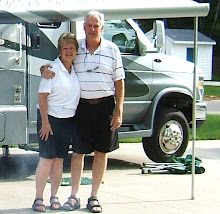




Breakfast at "The Antlers' before heading out this morning. If you are in the "SOO" you have to go! It is a little stone building across from the Hydro Plant. It is nothing special to look at until you get inside. There are numerous "stuffed" animals and it is very rustic as you can see. This is a taxidermy heaven!
Before we pulled out this morning we were stopped by 4 people asking about the coach. One woman said her husband had already been on line and took the phone number off the back to call them...so we did a tour (good thing we make the bed every morning.)
Off we go to spend the next 6 days in Tahquamenon Falls area in Paradise! We left the "Soo" on 6 mile road to Lakeshore Drive (Curley Lewis Hwy) to Rte 123 N. This route goes along the top of the UP and along the shorline of Lake Superior. Very few cars and the scenery is breathtaking.
Our first stop was Point Iroquois Light Station in the Hiawatha National Forest.The purpose of Point Iroquois was to guide freighters safely between the open waters of Whitefish Bay and the St. Mary's River. It served passing sailors by marking the narrow channel between the shallow sand bars and shoals off Point Iroquois and the rocky reefs of Gros Cap on the Canadian side of the bay. Keeping the light was demanding work. The lightkeeper had to be on duty throughout the night during the shipping season. Prior to electricity, a huge kerosene lamp provided the beacon's light source. keepers refilled the lamp with oil about every 4 hours and the wicks needed to be trimmed constantly.
Even with the aid of the light and fog horn, ships occaisonally foundered in the passage. Sixteen crewmen lost their lives in the freezing lake when the Steamer Myron went down in 1919 during one of the infamous November storms. Finding the bodies as they washed ashore, lightkeeper Elmer Byrnes (1920) took them to an undertaker in the neaby town. The undertaker would pay $10 a piece for "floaters". Because of heavy ship traffic , in 1902 the Lighthouse Service added to the building originaly built with the tower in 1870. The light station then had room for a head keeper, two assistants, and their families. In the 1950's , there were 3 families and eight children living at the lighthouse.
Driving along Ken spoted a place to pull off the road in a parking lot along a deserted beach. Nice thought but - ADVENTURE ALERT - he thought we had enough room to turn - we didn't as there was a big ditch we couldn't see under the grass. (We can't backup with the car attached) We pulled up as far as we could but the car was still crooked and we couldn't get the connecter bars loose from the towbar. We used a hammer and banged them out...don't want to do that again! Now we make very sure we have enough room to turn around (whew)!
Back on the road we stopped again at a pull through and walked down to a beach. Even though it was cloudy it was beautiful. No sign of anything human as far as you can see. Felt like Crusoe. We finally pulled into the Rivermouth Campground in Tahquamenon Falls State Park. We have a spot right on the river and there are very few people in the park right now.
Time to drive into Paradise to shop (another adventure). Paradise is the Wild Blueberry Capital of Michigan. We saw lots of bushes but too early for berries. Drive down main street and you will see small market (vintage 1950's), 2 restaurants, ice cream parlor, bake shop, and the deputy sheriffs house. This place is also rich with nautical folklore and it is truly a unique experience. It is the closest community to Tahquamenon Falls. We shopped at the little market and picked up enough food for a few days. We thought we would try the Youkon Inn for dinner (there were lots of trucks parked there). Well it' s the local Bar & Burger place so we had drinks ($5) and moved on. Found the Fish House and had broiled Lake Trout (fantastic).
Back at camp we went for a hike along the Tahquamenon River. All of a sudden there are two weird looking and very large birds in front of us. They were just ambling down the path and not paying us any attention. They looked prehistoric. (Of course the camera was in the car!) We found out from the park ranger that they were Sandhill Cranes. These Cranes are tall, stately birds with a heavy body, long neck and long legs. Standing four to five feet high and possessing a wing span of six to seven feet, Sandhill Cranes are Michigan's largest bird. Long, skinny legs and neck give a false impression of size; the males weigh an average of about 12 pounds and the females around 9-1/2 pounds. Except for this size difference, both sexes look alike. They were fun to watch and eventually they flew to the other side of the river. (Look them up on line they are really neat looking birds.)
This will be a great place to spend the 4th of July!
































